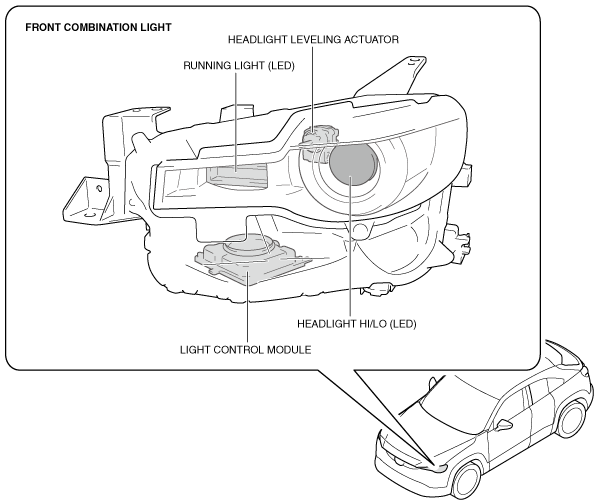FRONT COMBINATION LIGHT
id091800705500
Purpose
• The front combination light groups and houses together the parts related to the front exterior lights such as the headlight, running light, headlight leveling actuator, light control module, wiring harnesses, and connectors.
• Energy consumption reduction and maintenance-free design has been achieved with the adoption of LEDs on the headlights LO, HI, and running light.
• Visibility of road signs positioned higher up has been improved by blurring the cut lines of the headlights between light and dark to the greatest extent possible.
• Long distance visibility of pedestrians and roadside zones and short distance visibility during poor weather conditions such as rain and fog have been improved by expanding the light distribution of the headlights.
Function
• Each light illuminates or flashes when the light switch or turn switch is operated.
Structure/Construction
Without adaptive LED headlights
-
• The front combination light is integrated with the following parts:
-
― Headlight HI/LO (LED)
― Running light (LED)
― Headlight leveling actuator
― Light control module
-
• A projector type headlight has been adopted for the headlight HI/LO.
-
Note
-
• Fogging or condensation on the inside of the front combination lights may occur, however, it is a natural phenomenon occurring as a result of a temperature difference between the interior and exterior of the front combination lights and has no effect on the light performance.
• Fogging or condensation occurring as a natural phenomenon will dissipate when the temperature inside the front combination lights rises after the headlights are illuminated and a period of time has elapsed.
• Heat generated by the illumination of the LEDs is absorbed and dispersed by the heat radiation plates installed to the back of the headlight HI/LO reflectors.
• The optimized shape of the headlight LO and HI reflectors emits light over a wide area.
With adaptive LED headlights
-
• The front combination light is integrated with the following parts:
-
― Headlight HI/LO (LED)
― Headlight LO/running light (LED)
― Side-illuminating LED (LED)
― Headlight leveling actuator
― Light control module
-
• A projector type headlight has been adopted for the headlight HI/LO.
-
Note
-
• Fogging or condensation on the inside of the front combination lights may occur, however, it is a natural phenomenon occurring as a result of a temperature difference between the interior and exterior of the front combination lights and has no effect on the light performance.
• Fogging or condensation occurring as a natural phenomenon will dissipate when the temperature inside the front combination lights rises after the headlights are illuminated and a period of time has elapsed.
• Heat generated by the illumination of the LEDs is absorbed and dispersed by the heat radiation plates installed to the back of the headlight HI/LO reflectors.
• The optimized shape of the headlight LO and HI reflectors emits light over a wide area.
Operation
Headlight LO
1. When the light switch is in the HEAD position and the dimmer switch is in the LO position, the instrument cluster detects (1) a headlight LO signal.
2. The instrument cluster sends (2) the headlight LO signal to the body control module (BCM) via CAN communication.
3. When the body control module (BCM) receives the headlight LO signal with the ignition switched ON (engine off or on), it sends (3) a headlight LO on request signal to the light control module via CAN communication.
4. When the light control module receives the headlight LO on request signal, it turns the headlights LO on (4).
Headlight HI
1. When the dimmer switch is in the HI position, the instrument cluster detects (1) a headlight HI signal.
2. The instrument cluster sends (2) the headlight HI signal to the body control module (BCM) via CAN communication.
3. When the body control module (BCM) receives the headlight HI signal with the ignition switched ON (engine off or on), it sends (3) a headlight HI on request signal to the light control module via CAN communication.
4. When the light control module receives the headlight HI on request signal, it turns the headlights HI on (4).
Flash-to-pass
1. While the dimmer switch is in the FLASH-TO-PASS position, the instrument cluster detects (1) a flash-to-pass signal.
2. The instrument cluster sends (2) the flash-to-pass signal to the body control module (BCM) via CAN communication.
3. When the body control module (BCM) receives the flash-to-pass signal with the ignition switched ON (engine off or on), it sends (3) a headlight HI on request signal to the light control module via CAN communication.
4. When the light control module receives the headlight HI on request signal, it turns the headlights HI on (4).
Running light system
-
Headlight leveling actuator
-
Side-illuminating LED
-
